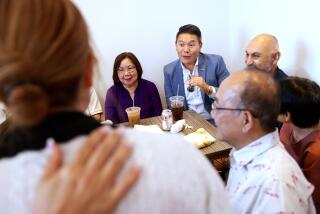Stranded Vietnamese: Ray of Hope
They have been adrift on a sea of uncertainty for 14 years, the last of the Vietnamese boat people still searching for a legal home. Now, the odyssey for some of the 2,000 Vietnamese refugees who are stuck stateless in the Philippines may be nearing an end.
The State Department, under prodding from lawmakers and legal advocates, is considering allowing some of those refugees to come to the United States, a move that would mark the final chapter in the nearly 30-year-old saga of Vietnam’s boat people.
“They’re stranded and have no place to go,” said Lan Quoc Nguyen, a Westminster attorney and Garden Grove Unified School District board member. “We feel a lot of sympathy for them. If they come to the United States, at least they will have a chance like we all did.”
Nguyen is among those in the Vietnamese American communities of Orange County and Virginia who have raised money to support the Philippine refugees and lobbied U.S. officials to allow them to immigrate here.
Today, Nguyen will join a small group of Little Saigon professionals who will travel to the Philippines, in a journey of hope, to provide legal advice, translation services and conduct mock interviews they hope will help the refugees get ready for the day they might meet with U.S. officials.
More than 1.5 million boat people escaped Vietnam after the war in a series of waves. The roughly 2,000 that remain in the Philippines were among the last to leave, beginning in 1989. They quickly found themselves ensnared in a bureaucratic web.
Many were rejected as political refugees by the Philippine immigration system. Because of that, U.S. officials could not consider them for resettlement under an international agreement to deal with the Vietnamese refugee crisis.
Another effort to resettle all remaining boat people in 1996 presented the refugees with what they saw as an unacceptable mandate: Go back to Vietnam, where they feared persecution, in order to be considered by U.S. immigration officials for resettlement.
When Philippine authorities tried to forceably fly the Vietnamese back, the refugees rioted at the airport. Catholic Church officials stepped in and successfully pressured the government to allow the Vietnamese refugees to remain indefinitely -- but with no legal status and no place to go.
“There’s an impression that these people are already settled in the Philippines,” said Thang Nguyen, executive director of the Virginia-based group Boat People SOS. “Even among Vietnamese Americans, a lot of them wrongly believe that they ... have legal status. But that’s not the case at all. They cannot get legal employment. They cannot legally own a business. They cannot own a house.”
Attorney Hoi Trinh understands their plight. “I could’ve easily been one of them,” he said.
Trinh, 33, is a Vietnamese attorney who fled Vietnam and resettled in Australia. In 1997, he gave up a job at a large law firm and moved to Manila to help the largely forgotten boat people, opening an office in a bedroom of his apartment where he prepares immigration appeals and lives on donations.
Trinh also has traveled repeatedly to Washington, where he lobbies government officials on behalf of the refugees. Some U.S. officials privately credit him -- and his passion -- with keeping their story alive.
“This is ... about seeing so much suffering and injustice and not being able to walk away from it,” Trinh said in an interview from Manila.
The last time Hong Pham saw her younger sister, she was handing her a bag of sugar, lemon drops and shredded chicken. It was 1989, and Tuyet Pham, her husband and two children were boarding a rickety fishing boat with more than 120 others to begin a risky escape from Vietnam.
Hong Pham, who would come to the United States under a humanitarian release five years later, assumed she would never see her sister again.
“I had to accept that she was dead,” Pham, who lives in Westminster, said as tears ran down her face. “It was difficult, but we took any opportunity for freedom.”
Today, Pham will be among those traveling to the Philippines. She will see her sister for the first time in 14 years and, she hopes, to smooth the way for her immigration to the United States.
“I’m going to cry,” she said. “I can only imagine what the reunion would be like. I’ve wished for this day long ago, but it has always been like a dream.”
Tuyet Pham, now 51, and her family spent seven days at sea and eventually were sent to a Manila refugee camp. Today, they still live on society’s margins, selling perfume, soap and other toiletries on the street and subsisting on vegetables they grow themselves.
“They’re surviving day by day,” Hong Pham said. “We send them money to help out.”
A State Department official who spoke on the condition of anonymity said the issue of the Philippine Vietnamese is being looked at, but there’s no timetable for a decision or a specific plan.
Of the 2,000 people that Vietnamese advocates are helping to get resettled, only about 1,400 are qualified for entry into the United States, the official said.
“The question is: Can we find a humane solution for this population?” she said.
In recent weeks, hope has run high in the Vietnamese American community -- and among the refugees themselves -- that a solution is near.
Tuyet Pham recently wrote her sister that she’s optimistic at getting another chance to interview with immigration officials: “The pain and suffering will be over soon.”
More to Read
Sign up for Essential California
The most important California stories and recommendations in your inbox every morning.
You may occasionally receive promotional content from the Los Angeles Times.










